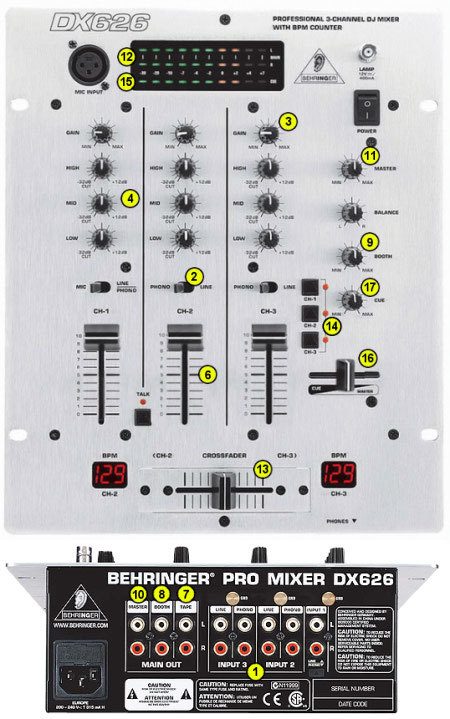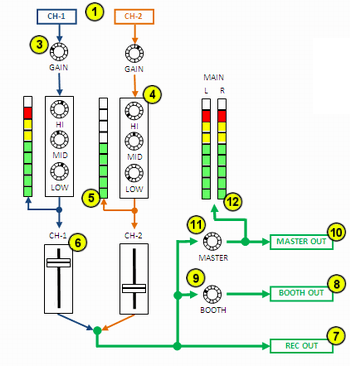
The Mixer Explained
The mixer is the core part of any DJ setup. With a mixer, the DJ mixes and routes the sound coming from the decks, and it’s the mixer that allows them to perform many of those cool DJ tricks. In this article, I’ll tell you about the most important controls found on a DJ mixer as well as the device’s features.
Instead of talking about each mixer control separately, I’ll try to cover the bigger picture. The diagram below shows how the sound signal from the turntables travels through the mixer and what knobs, faders and other controls it encounters on its path. Note that for the sake of simplicity, this diagram doesn’t include the crossfader, the headphone output section, or secondary controls.

So, the mixer has two channels, CH-1 and CH-2, to whose inputs (1) the players are hooked up. Those may be, for example, vinyl turntables, CD decks, or a laptop. Incidentally, the mixer has several inputs for each channel. Most often, there are two – Phono, for hooking up a vinyl turntable, and Line In, for hooking up a CD player or a computer. Special input switches (2) (see photo below) allow you to choose which one of the channel’s inputs currently feeds it the signal.
The first knob that the signal from the turntable encounters is Gain, also known as Trim (3). This knob sets the sound level of its channel. Gain’s purpose is to allow you to make sure that all signals coming into the mixer are of about the same overall volume. So if the record is too quiet, you boost it with Gain, and vice versa. (For more information on setting the volume level, see this article.)
After the Gain, the signal goes to the EQ (4). Most mixers have a three-band EQ with the knobs for treble (hi), midrange (mid) and bass (low). Each of these knobs allows you to adjust the level of its frequency band. Channel EQs are primarily used for smoother mixing.
After the EQ, the signal is picked up by the channel’s level meter (5), which shows the signal’s volume after the Gain and EQ. Channel meters are useful because they allow you to properly set the level even for those channels that can’t be currently heard on the dancefloor.
The next control the sound signal travels through is the channel upfader (6). The fader acts like a faucet and can entirely cut off the signal (fader closed), let it through at reduced volume (fader in an intermediate position) or let the signal through at full blast (fader open). It’s with the faders that the DJ changes the volume of the channels during the transition from one track to another.
At this point, the independent life of the channel comes to an end. After coming through the fader, its signal is mixed with the other channels’ ones and is sent to the device’s output. Of course, only channels whose faders are not closed can contribute to the mix.

Now let’s talk about the path of the combined signal before it leaves the mixer. First, it’s fed to the Rec Out output (7) to which the recording equipment can be hooked up. Rec Out’s level usually can’t be adjusted. Second, the mix is also fed to the Booth Out output (8), to which you can hook up your monitor speakers. The Booth, or Monitor knob (9) allows you to set the volume for those.
Finally, the mixed signal is fed to the Master Out output (10). This is the output to which the amplifier is hooked up. After amplifying the signal, the amp sends it to the speakers on the dancefloor, which (at last!) turn it into actual sound. The Master knob (11) lets you set the level of Master Out, and the Master Volume meter (12) shows you how loud the signal going to the amp is.
Now that the signal has successfully arrived at the mixer’s output, let’s talk about what was left out of the simplified diagram above. First of all, it’s the crossfader (13). Crossfader is a horizontal slider that lets you do smooth transitions between a pair of channels. When the crossfader is on the far right, only one channel’s signal is contributing to the mix. When the slider is on the far left, the same is true for the other channel. When the crossfader is in the middle, the dancefloor will hear both channels. The contribution of a particular channel to the overall mix is the greater the closer the crossfader is to the corresponding side.
I still haven’t mentioned monitoring the sound through headphones, and it’s too important to be left out. Most mixers have the concept of Cue Mix, also called PFL. Cue Mix makes it possible for you to hear (in your headphones) any channel, even one that’s not currently routed to the dancefloor. With the Cue Mix selection buttons (14), you can choose which channels you want to hear. Most often, a DJ chooses only one channel for the Cue Mix, which is the track they are checking out before bringing it in on the floor.
By the way, some mixers only have a Cue Mix level meter (15) instead of the per-channel ones. Thus in order to set the level of a channel on such a mixer, you can send the channel to the Cue Mix and monitor that meter.
You may think that you only need to have the Cue Mix in your headphones, but that’s not true. Sometimes (especially during transitions between tracks) you need to clearly hear what’s playing on the dancefloor, too. That’s why most mixers have the Cue Mix/Master knob or fader (16). It works similarly to the crossfader and lets you transition between the Cue Mix and the Master Out in your headphones.
Finally, there’s always the Cue knob, aka Headphone (17). As you have guessed, it simply lets you adjust the headphone volume.
About the Author JM
JM has played open-air gigs, shared the stage with the likes of ATB and had mix albums released commercially. He has been teaching DJing since 2008.
Session expired
Please log in again. The login page will open in a new tab. After logging in you can close it and return to this page.


i like dj stady
This is a very lovely article!
Great article, keep up the good work!
Thanks JT!
Thank you for sharing your knowledge…it is really helpful.
Thanks Jp!
Thanks very useful info , I’m having a bit of a problem I want to record I’ve got spilters for booth output ( phonos) which I’m using active speckers and recording with a sound card and computer at the same time would it be better to use the other slr cables in the other line out or does it matter
I think it doesn’t really matter.
Clear and well written. Thanks for sharing your knowledge!